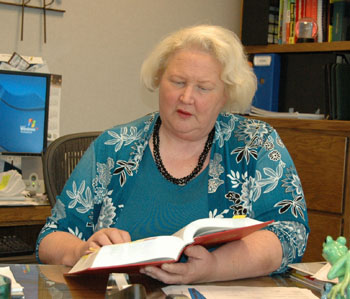By Lisa Yang

Barbara Forsland, Data Practices compliance and policy analyst, regularly receives requests from citizens, businesses, law firms, researchers, private investigators, state agencies and other interested parties for data about projects and the many other types of work that Mn/DOT performs. Photo by Lisa Yang |
Connecting the public to Mn/DOT’s information is a job that Barbara Forsland, Data Practices compliance and policy analyst, has served in for more than five years now.
Forsland began her career at Mn/DOT in the Office of Civil Rights in 1992. Her core work was to enforce equal employment and opportunity programs with contractors on construction projects and handle civil rights-related complaints from contract workers.
In early 2004, Forsland moved to the Data Practices unit and started out as a one-person office. The position was created to manage Mn/DOT’s response to requests for data. Under the Minnesota Government Data Practices Act, all agencies are required to provide access to all public government data held by the agencies.
Since the collapse of the Interstate 35W bridge in Minneapolis in 2007, Forsland has received an increased amount of requests from the public. Along with requests for data about the old and new I-35W bridges, requestors seek a variety of information including project data, river crossings, property acquisition data and railroad crossing data.
Upon receiving a request, what steps do you usually take to get the process going?
When I was a one-person office, I first explored agency records to see who had the information that was needed and then requested for the appropriate office to provide the information to me. Once I received the information, I reviewed it to determine what data was public and what data was classified as something other than public by state and federal legal standards. Then, I provided the public data to the requester.
How many requests do you receive on a regular basis, and what information is usually requested?
Before the bridge collapse, we would get 10 to 15 requests a month. Some were small and easy requests to fulfill and some were large and complex.
The collapse of the I-35W bridge changed the world of data practices. The volume of requests for information increased and even two years after the collapse of the bridge, the volume of requests is still higher than the volume before the collapse. Part of the reason for the increase is that the public has become more aware that they can get information from us.
The Data Practices Office regularly receives requests from citizens, businesses, law firms, researchers, private investigators, other agencies and other interested parties for data about projects and the many other types of work that Mn/DOT performs.
Describe what your job was like after the bridge collapsed.
It was very busy. I had to wear a pager at all times, which frequently called me out of meetings to handle other bridge-related issues. It was the single most challenging event since I began in Data Practices.
It also caused us to increase the size of our office. We’ve hired two people to help with the increase of requests. Peter Zuniga came on board to manage the electronic data related to the bridge collapse as a temporary appointment. We found his legal and technological skills to be indispensable and he became a permanent staff attorney in Data Practices. Sue Stein came to us from the Construction Office, and is now our office coordinator. She manages the flow of data practices requests and the database we use to track them and ensures that we complete fulfillment on schedule. Sue also manages the Data Practices Web site.
Our office has also used employees who were attorneys on a rotating basis due to the bridge collapse. Since then, we have hired temporary attorneys to assist with reviewing bridge-related data and we’ll be hiring four more attorneys this November for at least two months.
Are there upcoming topics that you feel will become hot button issues?
The bridge collapse continues to be of interest and requests may spike as the litigation receives more publicity.
River crossings have become a massive environmental concern to the public and to groups like the Sierra Club. These groups come forward with requests for volumes of information about how we make decisions.
Also, there are continued questions about employment of minorities including the hiring and use of Disadvantaged Business Enterprises in Mn/DOT’s construction work.
Usual concerns that I expect to continue receiving requests about are prevailing wages inquiries, stimulus projects, appraisals of property, Central Corridor issues and inquiries about specific projects.
What is the most fulfilling part of your job?
I enjoy working with every phase of work that our agency performs. We do so many things at Mn/DOT. Everyone here is so good at their jobs. They know what their jobs are and how to do get them done. When I don’t know the answer to something and need to get information from someone, I have never been refused. Everyone shares the information that they have and it makes my job easy and pleasant. It is a pleasure to meet all the people and learn about what they do. |



